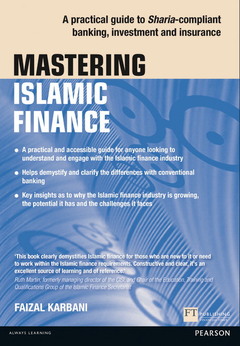Description
Mastering Islamic Finance: A practical guide to Sharia-compliant banking, investment and insurance
A practical guide to Sharia-compliant banking, investment and insurance
The Mastering Series
Author: Karbani Faizal
Language: English
Subjects for Mastering Islamic Finance: A practical guide to...:
208 p. · 16.4x24 cm · Paperback
Description
/li>Contents
/li>
A practical and accessible guide to Islamic finance that helps demystify the differences with conventional banking, enabling practitioners to develop Sharia compliant products for customers.
The Islamic Finance industry is estimated to be worth $1.2 trillion and is growing globally at over 10% per year. Mastering Islamic Finance will give practitioners an understanding of Islamic finance, from the basic techniques, through to advanced applications. Helping to demystify and clarify the differences with conventional banking, it will enable practitioners to develop Sharia compliant products for customers.
According to Sharia law there are strict rules on how financial services and products can be designed; in Islamic Finance money cannot make money and the subject of the finance must be an asset or a verifiable, real trade or business activity. Sharia compliant financial instruments have been devised to enable Muslims to abide by the principles of Islam and still make the most of their money.
Mastering Islamic Finance will equip readers with an understanding of Islamic financial instruments so they can sensibly apply them in practice. For each instrument there is a definition of the concept and how it differs from its equivalent in conventional banking. There are also examples and case studies to highlight practical applications.
About the author
Publisher’s acknowledgements
Author's acknowledgements
Part 1: Background
1. The Islamic Finance Phenomenon
Introduction
The Islamic finance phenomenon
Why does Islamic finance exist?
Why is Islamic finance now a sizeable and growing market?
Key challenges facing the industry
Conclusion
2. Islam – key beliefs, principles and practices
Introduction
Belief system
Key practices – the five pillars of action
Importance of the Qur’an and the Sunnah
Interpretation of the sharia
The role of scholars and sharia supervisory boards in Islamic finance
Conclusion
3. How Islamic finance differs from conventional banking
The Islamic economic model
Key Islamic finance principles
Conclusion
4. Valid commercial contracts in Islamic finance
Introduction
Key conditions for validity of contracts
Integrity of contractual arrangements
Status and use of promises
Part 2: Islamic Finance in Practice
5. Key transaction types in Islamic finance
Introduction
Equity type: transactions
Mudarabah (Partnership; one party contributes capital)
Musharakah (Partnership; both parties contribute capital)
Asset finance:
Murabaha (Sale of an asset at a known profit mark up)
Ijara (Leasing of an asset)
Istisn’a (Sale of an item to be constructed or manufactured)
Salam (Sale of fungible item yet to be produced)
Other key transaction types:
Wakala (Agent providing services to a Principal)
Hawalah (Transferring a debt)
Rahn (Providing security)
Kafalah (Providing a guarantee)
Conclusion
6. Sukuk
Introduction
Definition
Mechanics of a sukuk transaction
Types of sukuk
Asset-based versus asset-backed sukuk
Sukuk and the secondary market
A strong future for sukuk
Conclusion
7. Sharia-compliant investments and wealth management
Introduction
Sharia-compliant investments
Zakat by Iqbal Nasim
Sharia compliant estate distribution and Islamic wills by Haroon Rashid
Conclusion
8. Takaful – Islamic insurance
Introduction
Sharia perspective on conventional insurance
Takaful – the Islamic alternative
Takaful models
Types of takaful policy
The future of the takaful industry
Conclusion
9. The future of Islamic finance
Introduction
Recommendations for success by IFSB and IDB/IRTI
Opinion pieces
The Christian view of usury by Robert Van De Weyer
The future of Islamic finance by Dr Sayd Farook
The secret to long term success: get the direction of travel right by Faizal Karbani
Index
These books may interest you

Islamic Fintech 160.25 €



